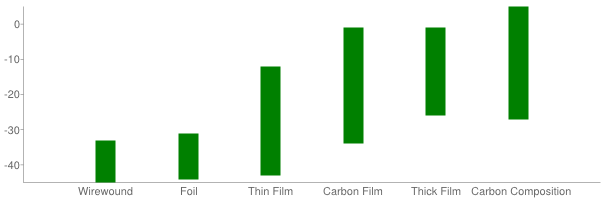What Is Resistor Noise?
Noise is an unwanted phenomenon for resistors. For some applications the noise properties are important. Examples are high gain amplifiers, charge amplifiers and low-level signals. Resistor noise is often specified as microvolt noise per volt of applied voltage, for a 1 MHz bandwidth. Thermal noise is the predominant source of noise for resistors. It is dependent on three variables: resistance, temperature and bandwidth. The relation between these three parameters is describes by the formula:

Where E is the RMS noise signal in volts, R is the resistance in ohms, k is Boltzmann’s constant, T is the temperature in Kelvin and dF is the bandwidth in Hz. The equation shows that the noise level can be decreased by reducing the resistance, the temperature or the bandwidth. Knowing Boltzmann’s constant, the formula is simplified to:

Where E is now the noise voltage in nanovolts, R in kΩ, and dF in kHz.
Noise standards
The way to measure resistor current noise is defined in norm IEC 60195. This makes the comparison of different manufacturers possible. The current noise of a resistor is described by the current noise index with a code number.
Thermal and current noise
There are two types of noise: the thermal noise and the current noise. To understand their principle, they will be discussed in more detail. In all materials, the electrons permanently move. As temperature increases, the movements increase. The vibrations of the electrons cause an electric signal (AC) across the terminals of the component. Because the vibrations are completely random, the electrical signal is noise. This is called thermal noise or Johnson noise. It is the main contributor to noise for resistors. Thermal noise is constant over a wide frequency range. Current noise however, declines when frequency is increased. The thermal noise increases with a larger resistance value, while the current noise decreases.
Resistor applications
In every amplifier circuit, the input resistor is critical. Any noise at the input signal will be amplified to the full gain. It is therefore of high importance to choose a low-noise resistor at the first stage, as well as a low resistance value. This is however not valid for a load resistor, since the gain that is obtained from a high resistance value outweighs the higher noise level. Because thermal noise is temperature dependent, it is very effective to cool the input stages to reach a low-noise performance.
Low Noise Resistor
Thin film, metal foil and wire wound resistors have better noise characteristics than other types. Therefore they are often specified in low-noise amplifying applications. The carbon composition resistor and thick film are of the worst types. They cope with high noise due to the construction and material. Microhm provides wide range of low noise resistors. The most popular ones are thin film resistors NLR30, NLR50, NLR100, metal foil resistor MPR series, wirewound resisotrs EE series.

Noise index (dB) for the main resistor types
Latest News
- Resistor's role in measuring and correcting LED,,,
- Single through-hole resistors' characteristics ,,,
- Why shunt resistors for current sense applicati,,,
- Metal-film resistors with small size, high resi,,,
- 36W High-Current Shunt Resistors MMS8420,,,
- 1W Surface Mount Resistor MPR1206,,,
- An Overview of Microhm Electronics' Resistor Pr,,,
- More anti-sulfur resistors used in harsh envir,,,
- Resistance changes with temperature,,,
- 140W TO247 High Power Heatsinkable Resistor,,,
- MMS5930 is ideal for current sensing in industr,,,
- Shunt resistors selection for engineers' design,,,
- Considerations for choosing precision resistors,,,
- Ceramic Encased Cement Resistors NWH Series for,,,
- Resistors for Passive Balancing in Battery-Pow,,,
Hot Articles
- Microhm will take part in 10th Automotive World,,,
- Thanks for Visiting Microhm's Booth E5-5706 in ,,,
- Resistors in Short Supply: Blame Cars,,,
- New lunch: High Power Precision Shunt Resistor,,,,
- How to Test a Resistor,,,
- Innovative Technology, Future Electric: Electri,,,
- What is Precision Resistors?,,,
- SMD Resistors Sizes and Packages,,,
- The Construction and Features of Metal Film Res,,,
- What is a TO-220 Resisor?,,,
- Hot Selling Products: Precision Shunt Resistors,,,
- How to Calculate the Equivalent Resistance Valu,,,
- What is a Fixed Resistor?,,,
- Resistors in LED Circuits,,,
- Resistors Types and Materials Overview,,,
Resistance applications
- Surface Mount Resistor's Size and Package ,,,
- Select the Right Resistor for Harmonic Filterin,,,
- Shunt Resistor MMS8420 for High Current Stable ,,,
- The Measurement Accuracy of Automotive Shunt is,,,
- Urbanization Development Bringing the Transform,,,
- Difference Between High Precision Resistors and,,,
- Heater Blower Motor Resistor in Air Conditioner,,,
- Precision Resistors' Construction and TCR,,,
- BMS for New Energy Vehicle,,,
- Carbon Film Resistors' Features and Application,,,
- Industrial Roberts Applied to Solar Photovoltai,,,
- The Main Application for High Precision and Low,,,
- Miniature future for passive electronic compone,,,
- Why Zero-Ohm Resistors?,,,
- The Four Important Functions of Alloy Resistors,,,
